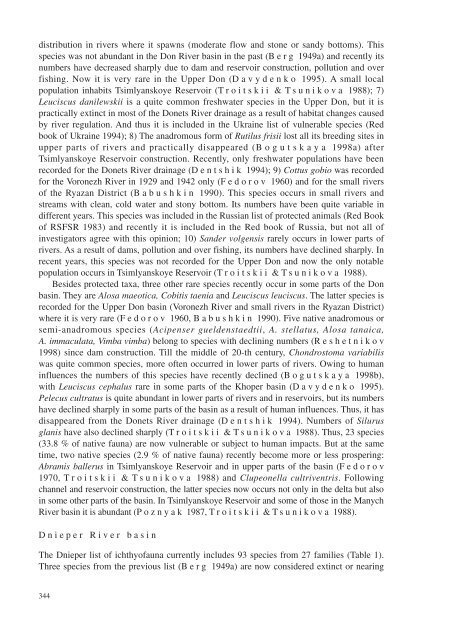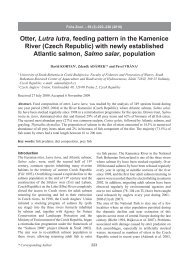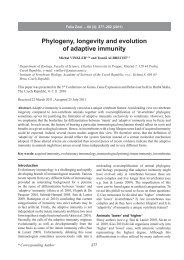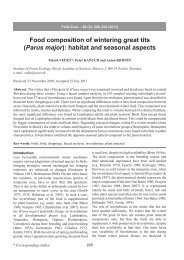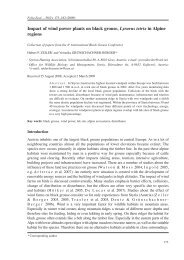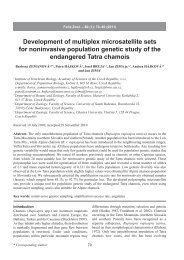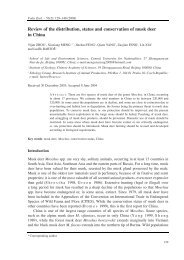alterations in ichthyofauna of the largest rivers
alterations in ichthyofauna of the largest rivers
alterations in ichthyofauna of the largest rivers
Create successful ePaper yourself
Turn your PDF publications into a flip-book with our unique Google optimized e-Paper software.
distribution <strong>in</strong> <strong>rivers</strong> where it spawns (moderate flow and stone or sandy bottoms). This<br />
species was not abundant <strong>in</strong> <strong>the</strong> Don River bas<strong>in</strong> <strong>in</strong> <strong>the</strong> past (B e r g 1949a) and recently its<br />
numbers have decreased sharply due to dam and reservoir construction, pollution and over<br />
fish<strong>in</strong>g. Now it is very rare <strong>in</strong> <strong>the</strong> Upper Don (D avydenko 1995). A small local<br />
population <strong>in</strong>habits Tsimlyanskoye Reservoir (T r o i t s k i i & T sunikova 1988); 7)<br />
Leuciscus danilewskii is a quite common freshwater species <strong>in</strong> <strong>the</strong> Upper Don, but it is<br />
practically ext<strong>in</strong>ct <strong>in</strong> most <strong>of</strong> <strong>the</strong> Donets River dra<strong>in</strong>age as a result <strong>of</strong> habitat changes caused<br />
by river regulation. And thus it is <strong>in</strong>cluded <strong>in</strong> <strong>the</strong> Ukra<strong>in</strong>e list <strong>of</strong> vulnerable species (Red<br />
book <strong>of</strong> Ukra<strong>in</strong>e 1994); 8) The anadromous form <strong>of</strong> Rutilus frisii lost all its breed<strong>in</strong>g sites <strong>in</strong><br />
upper parts <strong>of</strong> <strong>rivers</strong> and practically disappeared (B ogutskaya 1998a) after<br />
Tsimlyanskoye Reservoir construction. Recently, only freshwater populations have been<br />
recorded for <strong>the</strong> Donets River dra<strong>in</strong>age (Dentshik 1994); 9) Cottus gobio was recorded<br />
for <strong>the</strong> Voronezh River <strong>in</strong> 1929 and 1942 only (Fedorov 1960) and for <strong>the</strong> small <strong>rivers</strong><br />
<strong>of</strong> <strong>the</strong> Ryazan District (B abushk<strong>in</strong> 1990). This species occurs <strong>in</strong> small <strong>rivers</strong> and<br />
streams with clean, cold water and stony bottom. Its numbers have been quite variable <strong>in</strong><br />
different years. This species was <strong>in</strong>cluded <strong>in</strong> <strong>the</strong> Russian list <strong>of</strong> protected animals (Red Book<br />
<strong>of</strong> RSFSR 1983) and recently it is <strong>in</strong>cluded <strong>in</strong> <strong>the</strong> Red book <strong>of</strong> Russia, but not all <strong>of</strong><br />
<strong>in</strong>vestigators agree with this op<strong>in</strong>ion; 10) Sander volgensis rarely occurs <strong>in</strong> lower parts <strong>of</strong><br />
<strong>rivers</strong>. As a result <strong>of</strong> dams, pollution and over fish<strong>in</strong>g, its numbers have decl<strong>in</strong>ed sharply. In<br />
recent years, this species was not recorded for <strong>the</strong> Upper Don and now <strong>the</strong> only notable<br />
population occurs <strong>in</strong> Tsimlyanskoye Reservoir (T roitskii & Tsunikova 1988).<br />
Besides protected taxa, three o<strong>the</strong>r rare species recently occur <strong>in</strong> some parts <strong>of</strong> <strong>the</strong> Don<br />
bas<strong>in</strong>. They are Alosa maeotica, Cobitis taenia and Leuciscus leuciscus. The latter species is<br />
recorded for <strong>the</strong> Upper Don bas<strong>in</strong> (Voronezh River and small <strong>rivers</strong> <strong>in</strong> <strong>the</strong> Ryazan District)<br />
where it is very rare (Fedorov 1960, Babushk<strong>in</strong> 1990). Five native anadromous or<br />
semi-anadromous species (Acipenser gueldenstaedtii, A. stellatus, Alosa tanaica,<br />
A. immaculata, Vimba vimba) belong to species with decl<strong>in</strong><strong>in</strong>g numbers (Reshetnikov<br />
1998) s<strong>in</strong>ce dam construction. Till <strong>the</strong> middle <strong>of</strong> 20-th century, Chondrostoma variabilis<br />
was quite common species, more <strong>of</strong>ten occurred <strong>in</strong> lower parts <strong>of</strong> <strong>rivers</strong>. Ow<strong>in</strong>g to human<br />
<strong>in</strong>fluences <strong>the</strong> numbers <strong>of</strong> this species have recently decl<strong>in</strong>ed (B ogutskaya 1998b),<br />
with Leuciscus cephalus rare <strong>in</strong> some parts <strong>of</strong> <strong>the</strong> Khoper bas<strong>in</strong> (Davydenko 1995).<br />
Pelecus cultratus is quite abundant <strong>in</strong> lower parts <strong>of</strong> <strong>rivers</strong> and <strong>in</strong> reservoirs, but its numbers<br />
have decl<strong>in</strong>ed sharply <strong>in</strong> some parts <strong>of</strong> <strong>the</strong> bas<strong>in</strong> as a result <strong>of</strong> human <strong>in</strong>fluences. Thus, it has<br />
disappeared from <strong>the</strong> Donets River dra<strong>in</strong>age (D entshik 1994). Numbers <strong>of</strong> Silurus<br />
glanis have also decl<strong>in</strong>ed sharply (T roitskii & Tsunikova 1988). Thus, 23 species<br />
(33.8 % <strong>of</strong> native fauna) are now vulnerable or subject to human impacts. But at <strong>the</strong> same<br />
time, two native species (2.9 % <strong>of</strong> native fauna) recently become more or less prosper<strong>in</strong>g:<br />
Abramis ballerus <strong>in</strong> Tsimlyanskoye Reservoir and <strong>in</strong> upper parts <strong>of</strong> <strong>the</strong> bas<strong>in</strong> (Fedorov<br />
1970, T roitskii & Tsunikova 1988) and Clupeonella cultriventris. Follow<strong>in</strong>g<br />
channel and reservoir construction, <strong>the</strong> latter species now occurs not only <strong>in</strong> <strong>the</strong> delta but also<br />
<strong>in</strong> some o<strong>the</strong>r parts <strong>of</strong> <strong>the</strong> bas<strong>in</strong>. In Tsimlyanskoye Reservoir and some <strong>of</strong> those <strong>in</strong> <strong>the</strong> Manych<br />
River bas<strong>in</strong> it is abundant (Poznyak 1987, T roitskii & Tsunikova 1988).<br />
Dnieper River bas<strong>in</strong><br />
The Dnieper list <strong>of</strong> <strong>ichthy<strong>of</strong>auna</strong> currently <strong>in</strong>cludes 93 species from 27 families (Table 1).<br />
Three species from <strong>the</strong> previous list (B e r g 1949a) are now considered ext<strong>in</strong>ct or near<strong>in</strong>g<br />
344


